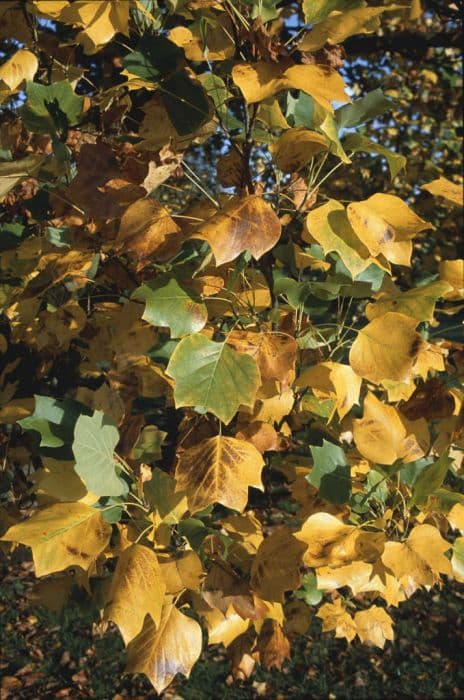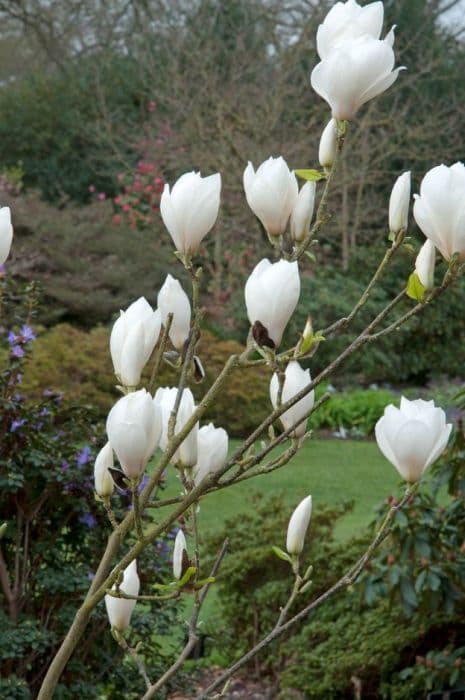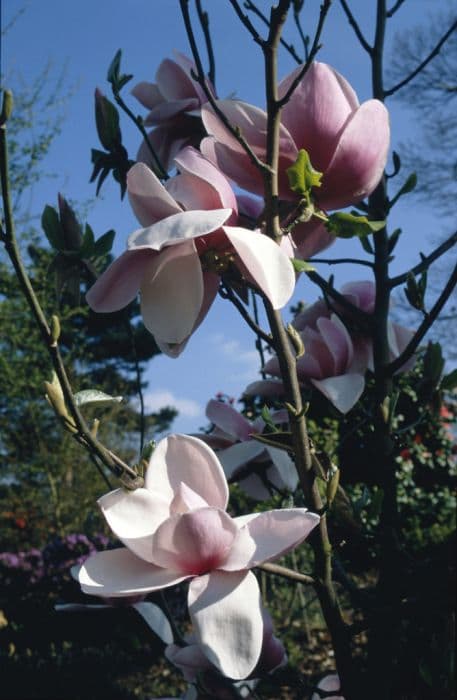Golden Gift Magnolia Magnolia 'Golden Gift'

ABOUT
The Magnolia 'Golden Gift' is an ornamental plant well-regarded for its striking floral display. This magnolia has a bushy, spreading form that showcases its large, glossy green leaves. The leaves create a dense canopy that provides a lush backdrop for its exceptional flowers. These blossoms are the main attraction of the Magnolia 'Golden Gift' – they are large, with a creamy-yellow hue, and have a lovely, cup-shaped form that adds an elegant touch to the garden when they emerge. Each flower is composed of multiple thick, waxy petals that unfurl from velvety buds, providing a contrast in texture. The blooms emit a delightful fragrance that can perfume the air around them, often detectable from a considerable distance. Beyond the striking beauty of the blooms, as the flowering season progresses, the flowers give way to the fruit, which adds additional interest to the shrub. The fruit of the Magnolia 'Golden Gift' is not its primary feature, but it contributes to the seasonal interest of the plant. Outside of its flowering period, the strong, branching structure of the Magnolia 'Golden Gift' becomes more visible and gives the plant a sturdy and attractive framework. This underlying structure helps the shrub maintain its visual interest throughout the year, even when not adorned with its characteristic blooms. Overall, the Magnolia 'Golden Gift' is a plant prized for its visual beauty and aromatic flowers, contributing elegance and a sense of luxury to any garden setting.
About this plant
 Names
NamesFamily
Magnoliaceae
Synonyms
Golden Gift Magnolia
Common names
Magnolia 'Golden Gift'
 Toxicity
ToxicityTo humans
Magnolia 'Golden Gift', which is commonly known as simply Magnolia, is generally not considered toxic to humans. There is limited information suggesting toxicity of Magnolias, and they are typically not listed among poisonous plants. However, as with any plant, individual reactions can vary, and it is always advisable to avoid ingesting plant material that is not specifically meant for consumption to prevent the risk of an allergic reaction or gastrointestinal discomfort.
To pets
Magnolia 'Golden Gift', commonly referred to as Magnolia, is not widely recognized as being toxic to pets. The American Society for the Prevention of Cruelty to Animals (ASPCA) does not list Magnolias as toxic to dogs, cats, or horses. Ingestion of plant parts like leaves or flowers might occasionally result in mild gastrointestinal upset, but serious toxicity is not typically expected. It's always best to monitor your pets and prevent them from eating ornamental plants to avoid any potential health issues.
 Characteristics
CharacteristicsLife cycle
Perennials
Foliage type
Deciduous
Color of leaves
Green
Flower color
Yellow
Height
10 feet (3 meters)
Spread
5 feet (1.5 meters)
Plant type
Tree
Hardiness zones
5
Native area
Southeast Asia
Benefits
 General Benefits
General Benefits- Ornamental Beauty: Magnolia 'Golden Gift' showcases bright yellow flowers which add aesthetic value to gardens and landscapes.
- Scented Flowers: The blooms emit a pleasant fragrance that can enhance the sensory experience of a garden.
- Seasonal Interest: This magnolia variety has a distinct blooming period that heralds the arrival of spring.
- Attracts Pollinators: The flowers can attract bees and other pollinators, supporting local ecosystems.
- Low Maintenance: Magnolia 'Golden Gift' is relatively easy to care for, requiring minimal upkeep once established.
- Drought Tolerance: Once established, it can withstand periods of drought, making it suitable for various climates.
- Year-Round Interest: The tree provides year-round interest, with evergreen or semi-evergreen foliage depending on the climate.
 Medical Properties
Medical Properties- This plant is not used for medical purposes.
 Air-purifying Qualities
Air-purifying QualitiesThis plant is not specifically known for air purifying qualities.
 Other Uses
Other Uses- Photography Prop: Magnolia 'Golden Gift' is often used as a beautiful backdrop or focal point in garden photography due to its vibrant yellow flowers.
- Wedding Decor: The elegant appearance of Magnolia 'Golden Gift' makes it suitable for use in wedding floral arrangements and venue decorations.
- Artistic Inspiration: Artists may use the unique form and color of Magnolia 'Golden Gift' flowers as inspiration for paintings, drawings, and textile designs.
- Dye Production: The petals of Magnolia 'Golden Gift' can be used to create a natural dye for fabrics, offering a gentle yellow hue.
- Culinary Garnish: Although not common, the petals of Magnolia 'Golden Gift' could be used as an edible garnish for sophisticated culinary presentations.
- Fragrance Collection: The subtle scent of Magnolia 'Golden Gift' may be captured and used in the production of perfumes or scented candles.
- Symbolic Gift: Due to its name and striking appearance, Magnolia 'Golden Gift' can be presented as a gift to symbolize appreciation and friendship.
- Education and Science: Magnolia 'Golden Gift' can serve as a subject for botany students and researchers studying hybridization and flowering plant characteristics.
- Relaxation Spaces: Planting Magnolia 'Golden Gift' in areas intended for relaxation can help create a tranquil environment due to its serene appearance.
- Cultural Events: Magnolia 'Golden Gift' can be incorporated into cultural and seasonal festivals as part of displays that celebrate plant life and gardening.
Interesting Facts
 Feng Shui
Feng ShuiThe Magnolia is not used in Feng Shui practice.
 Zodiac Sign Compitability
Zodiac Sign CompitabilityThe Magnolia is not used in astrology practice.
 Plant Symbolism
Plant Symbolism- Perseverance and Endurance: Magnolias are known to be tough and resistant; they're often one of the first plants to bloom, representing the ability to endure hard conditions.
- Purity and Nobility: Particularly with their white flowers, magnolias are often associated with purity. Their graceful appearance gives them a regal quality.
- Dignity: Magnolia trees have an imposing presence, often symbolizing a dignified and noble character.
- Feminine Beauty: With their delicate, large petals, magnolias can represent the simplicity and beauty of femininity.
- Eternal and Long-lasting: As magnolias can live for many years, they symbolize long-lasting nature, endurance, and eternity.
 Water
WaterThe Magnolia 'Golden Gift', commonly referred to as the Magnolia, should be watered thoroughly, allowing the soil to become moderately dry between waterings. Generally, this means watering every 7 to 10 days, but this schedule can vary depending on climate and season, with more frequent watering necessary during hot, dry periods and less during cooler, wet months. It is important to avoid waterlogging, so ensure good drainage. When watering, apply water directly to the soil until it is moist, not saturated, using approximately 1 to 2 gallons per session for a mature plant, depending on its size and the environmental conditions.
 Light
LightThe Magnolia 'Golden Gift' prefers full sun to partial shade for optimal growth. Planting it in a spot where it can receive at least 4 to 6 hours of direct sunlight a day is ideal. However, some afternoon shade can be beneficial in hotter climates to prevent leaf scorch.
 Temperature
TemperatureThe Magnolia 'Golden Gift' can withstand temperatures as low as 20 to 30 degrees Fahrenheit during dormancy in winter and can tolerate summer temperatures up to 90 degrees Fahrenheit. The ideal growing temperature range for this Magnolia is between 60 and 75 degrees Fahrenheit for healthy growth and flowering.
 Pruning
PruningPruning the Magnolia 'Golden Gift' is primarily for shaping and removing dead or damaged branches. It's best to prune after flowering, typically in late spring or early summer, to avoid cutting off next year's buds. Prune as needed, but try to keep it minimal as Magnolias do not require heavy pruning.
 Cleaning
CleaningAs needed
 Soil
SoilThe best soil mix for the Golden Gift Magnolia is one that is rich, well-drained, and slightly acidic with pH between 5.5 and 6.5. A mix of loamy soil, peat moss, and compost is recommended to retain some moisture and provide adequate nutrients.
 Repotting
RepottingGolden Gift Magnolias are generally slow-growing and may not need frequent repotting. Young plants should be repotted every 2-3 years, while mature specimens may only need repotting every 4-5 years to refresh the soil.
 Humidity & Misting
Humidity & MistingGolden Gift Magnolias prefer average to high humidity levels. While they are adaptable to various conditions, a relative humidity level of around 50% is considered ideal for these plants.
 Suitable locations
Suitable locationsIndoor
Place in bright, indirect light and ensure pot has good drainage.
Outdoor
Plant in moist, well-drained soil in a sunny spot.
Hardiness zone
5-9 USDA
 Life cycle
Life cycleThe life of a Magnolia 'Golden Gift', commonly known as Golden Gift Magnolia, begins with seed dormancy, where the encapsulated embryo rests within a protective covering until conditions are favorable. Following dormancy, germination occurs when moisture, temperature, and light conditions prompt the seed to sprout, developing its first roots and shoots. As a seedling, it slowly establishes itself, producing a set of true leaves that enable photosynthesis for energy. During its vegetative growth stage, the magnolia rapidly increases in size and develops a sturdy stem, with foliage becoming denser and the root system expanding for stability and nutrient uptake. Once mature, the Golden Gift Magnolia enters the reproductive stage, with characteristic large, fragrant yellow flowers that are capable of attracting pollinators and later producing seeds, thus enabling propagation. The plant may go through cycles of growth and reproduction annually, and can reach a significant age if provided with appropriate care and growing conditions.
 Propogation
PropogationPropogation time
Spring-early summer
Propogation: The Magnolia 'Golden Gift', commonly known as the Golden Gift Magnolia, is typically propagated through the method of softwood cuttings. This is best done in late spring to early summer when the new growth is just beginning to harden but is still flexible. You would take a cutting of about 4 to 6 inches (10 to 15 cm) long, ensuring it has at least two to three pairs of leaves. Remove the leaves from the bottom half of the cutting, and dip the cut end into a rooting hormone powder to encourage root development. Then, place the cutting in a well-draining soil mix or propagation medium, making sure at least one set of leaf nodes is buried where new roots can form. The cutting should be kept in a warm, humid environment with indirect light. After several weeks, once the cutting has established roots, it can be transplanted into a larger pot or its final location in the garden.









